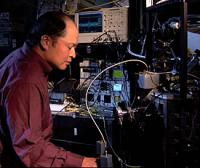Apr 19 2010
The National Institute of Standards and Technology’s (NIST) scientists have developed a single photon detector, the most efficient one in the world.
 NIST Phycisist Sae Woo Nam working on the refrigeration equipment that cools photon detectors
NIST Phycisist Sae Woo Nam working on the refrigeration equipment that cools photon detectors
This detector can count individual light particles passing a fiber optic cable with an efficiency of around 99%. It could help in improvements in the domain of optical power measurement, advanced quantum computation, and secure electronic communication.
Counting individual photons is beneficial for designers working on particular categories of quantum computers and also scientists focusing on experiments related to quantum optics. The quantum optics domain relates to light’s exotic states that classical physics theory is not able to explain. However, among the best potential applications for a highly efficient photon detector is safeguarding a long-distance data communication system against undesired interception. A detector capable of identifying that a photon that was a component of the long-range process is currently missing can provide a reasonable protection against theft of information.
Scientists used this technology five years back to achieve a detection efficiency of 88%.
Now they have improved the alignment of the optical fibers and the detector to enhance the photon detection ability. The photons are guided on to the detector by optical fibers. The detector utilizes a superconductor in the form of a very sensitive thermometer. The detector temperature is increased when ever it is struck by a photon, resulting in a small increase in electrical resistance that is registered as a photon’s presence by the instrument.
The detection process for the 810 nm infrared (IR) wavelength beam has been optimized by the team. The efficiency for other wavelengths relating to quantum optics and fiber optics communications domain is high. Surprisingly, this over-efficient detector outpaces the ability of the existing technology to find its precise efficiency.
The team is now focusing on developing evaluation techniques that would be able to match the abilities of the detector. The NIST Optoelectronics physicist division’s physicist and team member Sae Woo Nam informed that the team’s creation could enable the evaluation of various light-collection devices. He revealed that the benefit of this detector is that it accurately measures lower light levels. He added that in the past it was not possible to measure such low light levels.